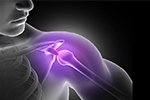Did you know that the shoulder has the best range of motion among all other joints in the body? Thanks to its unique structure, it allows you to use your arms to perform different kinds of movements.
However, it’s also because of this complex anatomy that the shoulder is highly susceptible to dislocations and injuries. A blow to the shoulder, overextension, extreme rotation and falls are some leading causes.
Whether you’re an athlete who wants to learn how to protect your shoulders from injuries or a patient already exploring your shoulder treatment options, learning about the joint’s structure can help you understand how it works and which activities put it at increased risk of injuries.
An Overview of the Shoulder Anatomy
The shoulder is an elaborate and complex ball-and-socket joint comprised of bones, joints, muscles, tendons, ligaments and cartilage that work together to support a wide range of motion.
Clavicle (Collarbone)
The collarbone is a long, S-shaped bone connecting the shoulder blade to the breastbone and the rest of the skeleton. It also attaches to muscles in the arm, neck and chest and allows free movement of the shoulder joint.
Scapula (Shoulder Blade)
The shoulder blade is a flat, triangular-shaped bone that attaches to the body mainly through muscles. It has three distinct processes (outgrowths allowing for muscle attachment and leverage): the acromion, spine and coracoid processes. The acromion process is a bony component that attaches to the clavicle.
Humerus (Upper Arm Bone)
The upper arm bone is a long bone running from the shoulder to the elbow. Its spherical top portion acts as the “ball” in this ball-and-socket joint and supports the shoulder’s wide range of motion.
Glenoid (The “Socket”)
It’s also worth mentioning the glenoid, the end of the scapula where the humeral head fits snugly. Compared to the hip socket, the glenoid cavity is a shallow socket, allowing a complete rotation of the joint. Unfortunately, this lack of depth also makes the shoulder prone to dislocations.
The Four Joints in the Shoulder Anatomy
You may understand by now that the shoulder is a ball-and-socket joint. With that said, there are actually four joints in the shoulder:
- Glenohumeral Joint: The main shoulder joint is where the humerus connects to the scapula. The shallowness of the glenoid cavity makes it the most mobile joint in the body – but also one of the most frequently dislocated.
- Acromioclavicular (AC) Joint: The AC joint is where the acromion process of the scapula attaches to the clavicle. Its primary role is stabilizing the shoulder and facilitating movements like lifting the arm upward.
- Sternoclavicular (SC) Joint: This saddle-shaped joint connects the clavicle to the sternum. As the only direct connection between the upper limb and the axial skeleton, the SC joint coordinates the upper limb’s movements with the trunk.
- Scapulothoracic Joint - While not an actual anatomical joint, it’s considered a gliding joint supporting overall shoulder function.
Muscles, Tendons, Ligaments and Cartilage
The shoulder also comprises a significant amount of soft tissue. The rotator cuff muscles, the group of muscles right outside the shoulder joint, help raise the arm, rotate the shoulder and support many daily activities. They also create a cuff to support the glenohumeral joint’s movement and keep the ball inside the glenoid cavity.
Tendons are responsible for attaching muscles to the bones. The biceps tendon originates from the biceps muscle and runs to the glenoid, where it attaches to the bone. There are also the four rotator cuff tendons, which connect the muscles’ deepest layer to the upper arm bone.
Ligaments, the soft tissue structures connecting bones to bones, provide stability to the shoulder and help keep it from dislocating. Finally, the labrum, a ring of elastic cartilage around the edge of the glenoid cavity, deepens the socket for the humerus to fit tightly, increasing the joint’s stability.
Common Injuries and Conditions Affecting the Shoulder
While the shoulder is remarkably flexible and mobile, its anatomy also makes it vulnerable to various injuries.
Rotator Cuff Injuries
Rotator cuff injuries refer to trauma to any of the muscles and tendons forming the rotator cuff and commonly include:
- Rotator Cuff Tears: These happen when a tendon is torn and no longer fully attaches to a bone. Degeneration from aging and injury are the leading causes of rotator cuff tears.
- Bursitis: This condition occurs when the bursa, the fluid-filled sacs reducing friction between the bones in the shoulder joint, become inflamed.
- Tendinitis: This refers to the inflammation of the tendons and usually happens after sporting or repetitive overhead movements irritate or damage the tendons.
Labral Tears
Labral tears are injuries to the cartilage ring in the shoulder joint, which may be caused by falls or collisions, often in sports. Some symptoms include:
- A dull, throbbing pain in the shoulder joint
- Pain with specific activities
- A “catching” sensation when the shoulders are moved
- For athletes, a loss of strength in the shoulders
Biceps Tendon Injuries
The biceps muscle is attached to the shoulder’s scapula bone and the radius bone at the elbow by two tendons. While these tendons are tough, they can become inflamed or develop tears through overuse or trauma.
Biceps tears may be partial or complete and can occur due to overuse or injury. Meanwhile, biceps tendinitis is the inflammation of the long tendon, which can develop in aging adults or athletes who perform repetitive overhead motions in their sports.
Shoulder Dislocations and Instability
Severe trauma like falls and sports accidents can force the upper arm bone’s spherical top portion out of the shoulder blade’s socket. Shoulder dislocations can be treated through closed and open reduction.
Acromioclavicular (AC) Joint Injuries
As the joint connects your collarbone and shoulder blade along with ligaments, an injury to the acromioclavicular joint is essentially a shoulder separation. It can occur after a direct blow or trauma to an outstretched arm or the top of the shoulder.
AC joint injuries are often treated with immobilization or surgical reconstruction, depending on the severity of the injury, degree of separation and a patient’s activity levels.
Arthritis
Arthritis is damage to a joint’s cartilage. In people with arthritis of the shoulder, the wearing down of the cartilage on the ball and/or socket sides of the joint causes pain, stiffness and reduced range of motion.
Different types of arthritis can affect the shoulder, such as osteoarthritis, post-traumatic arthritis, rheumatoid arthritis and rotator cuff tear arthropathy.
Get Tailored Shoulder Treatment for Your Pain or Injury
The shoulder’s intricate structure provides a wide range of motion and maximum mobility that lets you perform various tasks. Whether you’re pushing a door open, reaching for an item on a shelf or doing your signature backhand swing, its anatomy gets your arm in the correct position.
With this, a painful or stiff shoulder can make sports activities and even daily life difficult. The good news is that various treatment options are available today, and Dr. Benjamin Domb can guide you through the most suitable choice for your specific injury and lifestyle goals. Contact (833) 872-4477 or fill out this form to request an appointment today.

